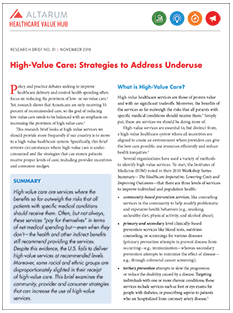Improving Value
High Value Care
High-value care is broadly defined as healthcare services with benefits that so far outweigh the risks that all patients in a given population should receive them. Oftentimes, these services "pay for themselves" in terms of net medical spending but — even when they don't — the health outcomes and other indirect benefits justify their provision.
For example, the National Commission on Prevention Priorities released a list in 2016 of 28 high-value services with strong evidence of effectiveness, population-wide health impact and cost-effectiveness.1 Highest ranked services included immunizing children, counseling to prevent tobacco initiation among youth, and tobacco-use screening and brief intervention to encourage cessation among adults; alcohol misuse screening with brief intervention, discussing aspirin use with high-risk adults, colorectal cancer screening, cervical cancer screening, chlamydia and gonorrhea screening, cholesterol screening, hypertension screening, obesity screening and more.
Despite this evidence, the U.S. fails to deliver these high-value services at recommended levels. Moreover, some racial and ethnic groups receive high-value services even less frequently than other groups, worsening health disparities. High-value care is often underutilized by individuals with multiple chronic diseases, low-income and minority populations, and patients undergoing care transitions.2 For example, one study found only one-third of the potential health and economic benefits of tobacco counseling are being realized.3 Moreover, researchers have demonstrated patients with chronic diseases such as hypertension, heart disease, and diabetes often do not receive proven and effective treatments such as drug therapies or self-management services to help them more effectively manage their conditions. This is true for insured, uninsured, and under-insured Americans.4
By increasing the use of high-value, cost-effective care we can achieve better outcomes, reduce health inequities and possibly save money—more than $55 billion each year according to one estimate.5
Strategies to increase the provision of high-value care are include aligning provider payment and contracting to support high-value care, real-time clinical decision support systems, and public reporting of progress. Our issue brief examines the community, provider and consumer strategies that can increase the use of high-value services.
Notes
1. American Academy of Family Physicians, "National Commission on Prevention Prirorities Releases New Preventive Services Rankings," (January 9, 2017).
2. Brennan, Niall, et al., "Improving Quality and Value in the U.S. Health Care System," Brookings (August 21, 2009).
3. American Academy of Family Physicians, "National Commission on Prevention Priorities Releases New Preventive Services Rankings," (January 9, 2017).
4. Brennan, Niall, et al., "Improving Quality and Value in the U.S. Health Care System," Brookings (August 21, 2009).
5.Satcher, David, "Preventive Interventions: An Immediate Priority," Annals of Family Medicine (January 2017).








